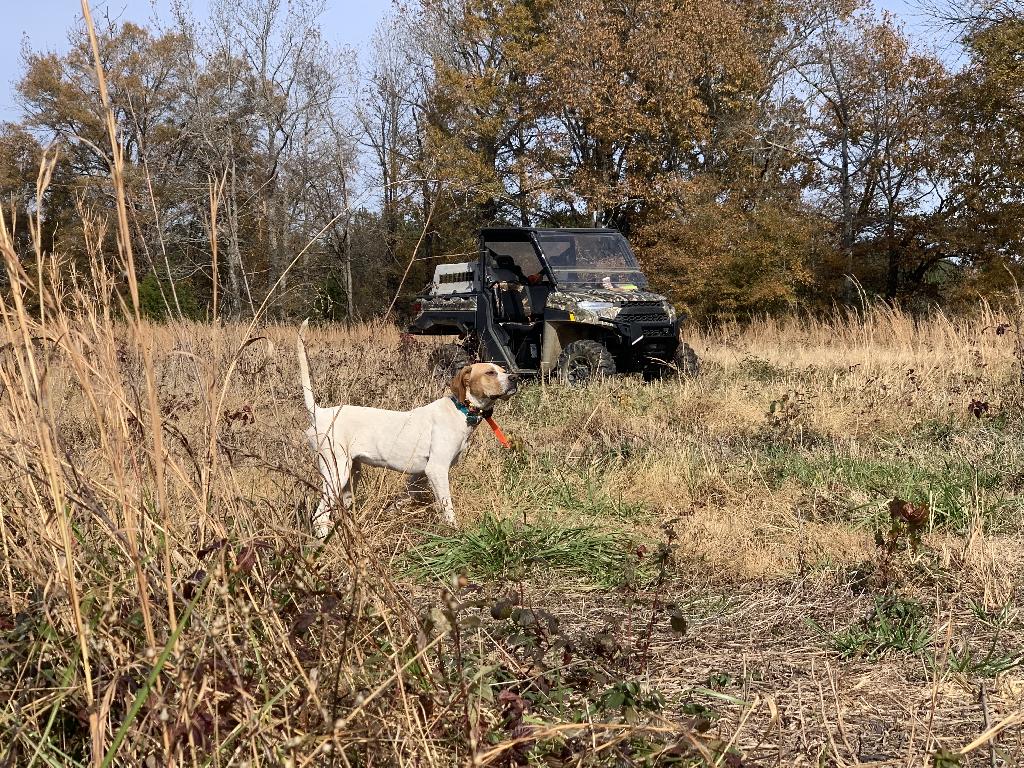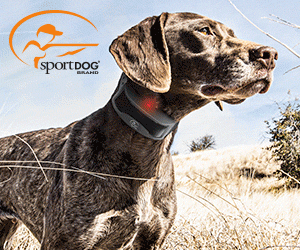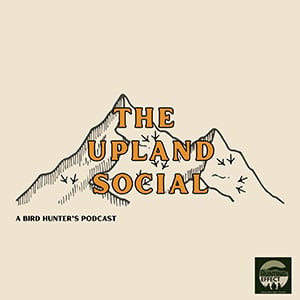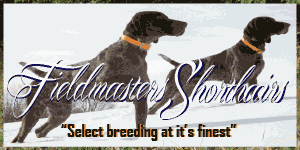Comparing Performance Metrics of Bird Dogs by Gender
Battle of the Sexes: English Pointer Edition
Posted 06/19/2023
If you ask any bird-dog enthusiast what they look for when choosing a future upland dog and hunting companion, you are bound to get a wide array of advice. Many bird-dog enthusiasts favor specific breeds and bloodlines that align with the species of upland game they pursue or the hunting methods they use (i.e., walk hunting vs. horseback, etc.). When selecting puppies, they may favor certain mannerisms, such as boldness vs. timidness, or with a preferred conformation or coloration. Most enthusiasts also prefer a specific gender—male vs. female.

As honest as these recommendations may be, they all come from personal experiences that are often heavily biased. For instance, having owned and worked with many bird dogs, I prefer a bold female with a sleek confirmation. Although I could use a logical explanation based on performance, I’ll admit that it is probably based on an association with my first bird dog. She was a liver and white German shorthaired pointer female I found under my Christmas tree when I was six years old (Figure 1; a & b). I named her Charlotte (after Charlotte’s Web) and hunted pheasant and the occasional rabbit behind her for 12 years. She traveled everywhere with us like a family member; unlike our other dogs, she lived in the house. Since Charlotte, I’ve been fortunate to own and work with many other great bird dogs of various breeds and sex, but very few have genuinely measured up to my memories of her.

Therefore, it’s easy to question the validity of any recommendation or preference. Validating these recommendations is often impossible due to the lack of unbiased data (i.e., performance records) necessary to make comparisons. However, a recent study in South Texas has provided us with a relatively large, unbiased data set that allows us to compare male and female performance metrics within the English pointer breed. The project analyzed the spatial and temporal aspects of northern bobwhite hunts by tracking hunting dogs using GPS units and detailed hunting logs (i.e., dogs, brace times, covey finds, false points, etc.).
These hunts were recorded during the 2018-2019, 2019-2020, and 2020-2021 statewide quail hunting seasons. We recorded tracklogs and hunting parameters from 153 individual bird dogs, of which 143 were English pointers. The dogs were owned and handled by 9 different professional guides. Some dogs were used during two seasons (40 dogs), and some were recorded in all three hunting seasons (32 dogs).
Of the 143 English pointers utilized, 63 were female, and 80 were male. Although males were slightly favored by the guides (male = 56% vs. female = 44%), a higher proportion of the total females were used during all three of the hunting seasons (25%) compared to the proportion of total males used in all three hunting seasons (17.5%). The average age was the same across sexes, with an average age of both males and females at 4.3 years old (Figure 2).

Brace and Hunt Time
In total, 668 hours of bobwhite hunting were recorded. This included all activity that would result in a harvest if a covey encounter occurred. The activities were broken down into two categories: brace times (i.e., dog(s) actively hunting) and truck hunting (i.e., road hunting, relocating). Brace time with pointers represented 82% of the hunting activity (549.2 hrs.), with a total of 836 braces recorded. Five of the 836 braces recorded had only one dog on the ground (1.7 hrs.), and the remaining had two dogs per brace (547.5 hrs.). Therefore, the total dog time recorded was 1096.7 hours.
Even though more male pointers were hunted during the study, the total amount of brace time was skewed toward females. Females had 57% (628.0 hrs.) of the total run time versus 43% (468.7 hrs.) for males. This seems illogical but is easily explained when looking at the composition of the braces with multiple dogs. Eighty-three percent (693 braces) of the brace pairs were one male and one female, 12% (99 braces) were with two females, and 5% (39) were with two males. In fact, the top ten females with the most brace time accounted for 38% of the total dog hours (416.7 hrs.), while the top ten males only accounted for 25% (279.4 hrs.).
Velocity, Redundancy, and Area Hunted
To calculate the mean velocity of individual dogs, we divided the total length of each dog’s track by the total run time. The average velocity was similar between the sexes, with males averaging 6.3 mph (range = 2.4–12.9 mph) during hunts and females averaging 6.0 mph (range = 1.9–12.5 mph; Figure 3).

Naturally, bird dogs quarter in the field in front of hunters (or hunting vehicles). This constant quartering back and forth creates some redundancy (or overlap) of the area hunted by an individual dog and between dogs when hunting in a brace. Lower redundancy correlates to more efficient hunting patterns and more acreage covered for the effort exerted. Therefore, we calculated the area effectively covered and redundancy by using a standard buffer (point-to-flush distance) around each GPS track. Our findings for the area covered per hour were also similar between the sexes. The average male covered the field at a rate of 21.2 acres per hour, and females covered 16.2 acres per hour. We found a high amount of variation in redundancy of the area hunted between all dogs (range = 20–47%), but the mean redundancy between sexes was similar (male = 32.3% vs. female = 33.5%).
One thing to consider is that these rates included all hunting behavior (i.e., searching, pointing, or backing), and therefore an increase in the number of overall points (e.g., false points or points with coveys) is additional time spent at 0 velocity and 0 acres covered per hour.
Endurance
Unlike most places, daily temperatures in South Texas can fluctuate drastically. The temperature during the hunts we recorded ranged from 34ºF to 85ºF. To maintain performance under these conditions, bird dogs need a high level of endurance or stamina.
To measure endurance, you need to account for the speed at which the dog ran and its total run time. Therefore, we used the average length per run (MPH X Run Time) for our comparisons. Overall, males ran 173 yards less than females (male = 6,521 yards vs. female = 6,694 yards) on average. However, when analyzing the top ten performers (i.e., total productive points) of either sex, the average length per run favored males by a distance of 185 yards (male = 7,904 yards vs. female = 7,719 yards). This may seem insignificant, but we can assume the top ten males are covering an additional acre (1.1 acres) per brace compared to the top ten females.
Productive and Unproductive Points
In total, males were credited with 991 productive points (i.e., bobwhites found), and females were credited with 976. Males also had 281 unproductive points (i.e., false points, points with no quail produced), while females had 300 unproductive points (Figure 4).

Considering the differences in the total number of dogs per sex (80 males vs. 63 females) and within the proportion of hunt time, a better analysis is to look at the pointing rates per hour. Males had a rate of 1.7 productive points per hour (covey found every 35 minutes) and 0.7 unproductive points per hour. Females were slightly lower, with 1.6 productive points per hour (covey find every 38 minutes) and 0.6 unproductive points per hour.
The difference in productivity between sexes increases when looking at the top ten performers (i.e., total productive points). The top ten males had a rate of 2.3 productive points per hour (covey found every 26 minutes) and only 0.6 unproductive points, while the top ten females had 1.8 productive points per hour (covey found every 33 minutes) and 0.5 unproductive points.
Conclusions…Which Gender Wins?
To our surprise, the performance metrics we measured were relatively similar across genders, and although the average values were different, the differences were not statistically different from zero. But, generally speaking, we found that the average male was slightly faster (~0.3 mph faster), covered more acreage per hour (~5.0 acres more), but had slightly lower endurance when measuring for velocity and run time. The average males also had a higher rate of points per hour, both productive points per hour and unproductive.
When looking at the top ten performing dogs of either sex based on total covey points, we found that the top ten males had higher endurance metrics (~185 yards further) and a statistically significant difference in the number of productive points per hour, which happens to be the only significant difference we found (males = 2.3 vs. females = 1.8). This is an important finding, mainly because the “success” of a quail hunt is measured by the number of coveys found per hour (or the total number of coveys per day). If males have a statistically higher rate of coveys finds per hour, then logically, guides who favor male pointers would have increased success per outing.
This should not be a surprising statistic. If we look at the National Field Trial Champions from 1896 to the present day (123 years), we see that 73% (90) of those champions were male, and only 27% (33) were female. Although judging a field trial is more sophisticated and comprehensive than the metrics we measured, this is additional evidence for our findings, considering productive points are still the definitive measurement of any field trial performance.
However, this does not consider the other facets of “dog work” that dictate an excellent hunting performance. For instance, we only credited the dog that initially pointed the covey, with no documentation or credit given for honoring (i.e., backing) or working singles after the initial covey rise. Many dogs run big and are amazing “bird-finders,” but once a covey is found, they have no interest in working close or looking for a downed game. The value of the bird-dog who will hunt close, honor another dog’s point, and find the downed game was not measured within our data set.
So, if you’re hoping for the next field champion or a dog that will cover ground and potentially find a few more birds per hour, your odds are increased if you select a male. If you are like me and appreciate all dogs, the ones that run far and work closely, as well as those that honor and find dead game, you may want to get a few of each!
The author would like to thank the East Foundation for access and generous funding, Dr. Andrea Montalvo for reviewing this article, and the coauthors on the original manuscript: Dr. Leonard Brennan, Dr. Fidel Hernández, Dr. Humberto Perotto-Baldivieso, and Dr. Neal Wilkins. For more information regarding the East Foundation’s Sustainable Bobwhite Harvest Project, see https://eastfoundation.net/science/research-projects/sustainable-harvest-and-management-of-northern-bobwhites/.

As honest as these recommendations may be, they all come from personal experiences that are often heavily biased. For instance, having owned and worked with many bird dogs, I prefer a bold female with a sleek confirmation. Although I could use a logical explanation based on performance, I’ll admit that it is probably based on an association with my first bird dog. She was a liver and white German shorthaired pointer female I found under my Christmas tree when I was six years old (Figure 1; a & b). I named her Charlotte (after Charlotte’s Web) and hunted pheasant and the occasional rabbit behind her for 12 years. She traveled everywhere with us like a family member; unlike our other dogs, she lived in the house. Since Charlotte, I’ve been fortunate to own and work with many other great bird dogs of various breeds and sex, but very few have genuinely measured up to my memories of her.

Therefore, it’s easy to question the validity of any recommendation or preference. Validating these recommendations is often impossible due to the lack of unbiased data (i.e., performance records) necessary to make comparisons. However, a recent study in South Texas has provided us with a relatively large, unbiased data set that allows us to compare male and female performance metrics within the English pointer breed. The project analyzed the spatial and temporal aspects of northern bobwhite hunts by tracking hunting dogs using GPS units and detailed hunting logs (i.e., dogs, brace times, covey finds, false points, etc.).
These hunts were recorded during the 2018-2019, 2019-2020, and 2020-2021 statewide quail hunting seasons. We recorded tracklogs and hunting parameters from 153 individual bird dogs, of which 143 were English pointers. The dogs were owned and handled by 9 different professional guides. Some dogs were used during two seasons (40 dogs), and some were recorded in all three hunting seasons (32 dogs).
Of the 143 English pointers utilized, 63 were female, and 80 were male. Although males were slightly favored by the guides (male = 56% vs. female = 44%), a higher proportion of the total females were used during all three of the hunting seasons (25%) compared to the proportion of total males used in all three hunting seasons (17.5%). The average age was the same across sexes, with an average age of both males and females at 4.3 years old (Figure 2).

Brace and Hunt Time
In total, 668 hours of bobwhite hunting were recorded. This included all activity that would result in a harvest if a covey encounter occurred. The activities were broken down into two categories: brace times (i.e., dog(s) actively hunting) and truck hunting (i.e., road hunting, relocating). Brace time with pointers represented 82% of the hunting activity (549.2 hrs.), with a total of 836 braces recorded. Five of the 836 braces recorded had only one dog on the ground (1.7 hrs.), and the remaining had two dogs per brace (547.5 hrs.). Therefore, the total dog time recorded was 1096.7 hours.
Even though more male pointers were hunted during the study, the total amount of brace time was skewed toward females. Females had 57% (628.0 hrs.) of the total run time versus 43% (468.7 hrs.) for males. This seems illogical but is easily explained when looking at the composition of the braces with multiple dogs. Eighty-three percent (693 braces) of the brace pairs were one male and one female, 12% (99 braces) were with two females, and 5% (39) were with two males. In fact, the top ten females with the most brace time accounted for 38% of the total dog hours (416.7 hrs.), while the top ten males only accounted for 25% (279.4 hrs.).
Velocity, Redundancy, and Area Hunted
To calculate the mean velocity of individual dogs, we divided the total length of each dog’s track by the total run time. The average velocity was similar between the sexes, with males averaging 6.3 mph (range = 2.4–12.9 mph) during hunts and females averaging 6.0 mph (range = 1.9–12.5 mph; Figure 3).

Naturally, bird dogs quarter in the field in front of hunters (or hunting vehicles). This constant quartering back and forth creates some redundancy (or overlap) of the area hunted by an individual dog and between dogs when hunting in a brace. Lower redundancy correlates to more efficient hunting patterns and more acreage covered for the effort exerted. Therefore, we calculated the area effectively covered and redundancy by using a standard buffer (point-to-flush distance) around each GPS track. Our findings for the area covered per hour were also similar between the sexes. The average male covered the field at a rate of 21.2 acres per hour, and females covered 16.2 acres per hour. We found a high amount of variation in redundancy of the area hunted between all dogs (range = 20–47%), but the mean redundancy between sexes was similar (male = 32.3% vs. female = 33.5%).
One thing to consider is that these rates included all hunting behavior (i.e., searching, pointing, or backing), and therefore an increase in the number of overall points (e.g., false points or points with coveys) is additional time spent at 0 velocity and 0 acres covered per hour.
Endurance
Unlike most places, daily temperatures in South Texas can fluctuate drastically. The temperature during the hunts we recorded ranged from 34ºF to 85ºF. To maintain performance under these conditions, bird dogs need a high level of endurance or stamina.
To measure endurance, you need to account for the speed at which the dog ran and its total run time. Therefore, we used the average length per run (MPH X Run Time) for our comparisons. Overall, males ran 173 yards less than females (male = 6,521 yards vs. female = 6,694 yards) on average. However, when analyzing the top ten performers (i.e., total productive points) of either sex, the average length per run favored males by a distance of 185 yards (male = 7,904 yards vs. female = 7,719 yards). This may seem insignificant, but we can assume the top ten males are covering an additional acre (1.1 acres) per brace compared to the top ten females.
Productive and Unproductive Points
In total, males were credited with 991 productive points (i.e., bobwhites found), and females were credited with 976. Males also had 281 unproductive points (i.e., false points, points with no quail produced), while females had 300 unproductive points (Figure 4).

Considering the differences in the total number of dogs per sex (80 males vs. 63 females) and within the proportion of hunt time, a better analysis is to look at the pointing rates per hour. Males had a rate of 1.7 productive points per hour (covey found every 35 minutes) and 0.7 unproductive points per hour. Females were slightly lower, with 1.6 productive points per hour (covey find every 38 minutes) and 0.6 unproductive points per hour.
The difference in productivity between sexes increases when looking at the top ten performers (i.e., total productive points). The top ten males had a rate of 2.3 productive points per hour (covey found every 26 minutes) and only 0.6 unproductive points, while the top ten females had 1.8 productive points per hour (covey found every 33 minutes) and 0.5 unproductive points.
Conclusions…Which Gender Wins?
To our surprise, the performance metrics we measured were relatively similar across genders, and although the average values were different, the differences were not statistically different from zero. But, generally speaking, we found that the average male was slightly faster (~0.3 mph faster), covered more acreage per hour (~5.0 acres more), but had slightly lower endurance when measuring for velocity and run time. The average males also had a higher rate of points per hour, both productive points per hour and unproductive.
When looking at the top ten performing dogs of either sex based on total covey points, we found that the top ten males had higher endurance metrics (~185 yards further) and a statistically significant difference in the number of productive points per hour, which happens to be the only significant difference we found (males = 2.3 vs. females = 1.8). This is an important finding, mainly because the “success” of a quail hunt is measured by the number of coveys found per hour (or the total number of coveys per day). If males have a statistically higher rate of coveys finds per hour, then logically, guides who favor male pointers would have increased success per outing.
This should not be a surprising statistic. If we look at the National Field Trial Champions from 1896 to the present day (123 years), we see that 73% (90) of those champions were male, and only 27% (33) were female. Although judging a field trial is more sophisticated and comprehensive than the metrics we measured, this is additional evidence for our findings, considering productive points are still the definitive measurement of any field trial performance.
However, this does not consider the other facets of “dog work” that dictate an excellent hunting performance. For instance, we only credited the dog that initially pointed the covey, with no documentation or credit given for honoring (i.e., backing) or working singles after the initial covey rise. Many dogs run big and are amazing “bird-finders,” but once a covey is found, they have no interest in working close or looking for a downed game. The value of the bird-dog who will hunt close, honor another dog’s point, and find the downed game was not measured within our data set.
So, if you’re hoping for the next field champion or a dog that will cover ground and potentially find a few more birds per hour, your odds are increased if you select a male. If you are like me and appreciate all dogs, the ones that run far and work closely, as well as those that honor and find dead game, you may want to get a few of each!
The author would like to thank the East Foundation for access and generous funding, Dr. Andrea Montalvo for reviewing this article, and the coauthors on the original manuscript: Dr. Leonard Brennan, Dr. Fidel Hernández, Dr. Humberto Perotto-Baldivieso, and Dr. Neal Wilkins. For more information regarding the East Foundation’s Sustainable Bobwhite Harvest Project, see https://eastfoundation.net/science/research-projects/sustainable-harvest-and-management-of-northern-bobwhites/.



















